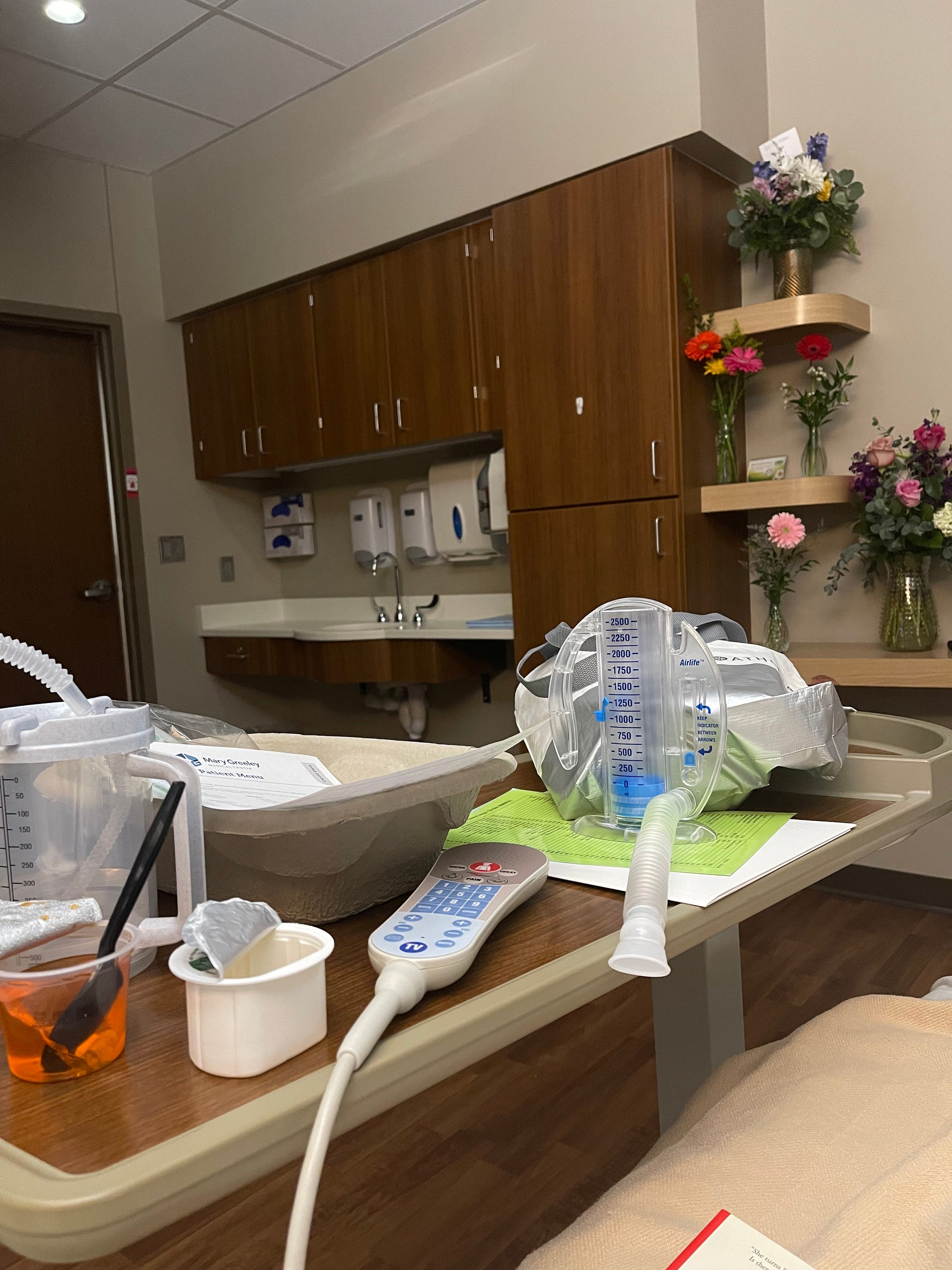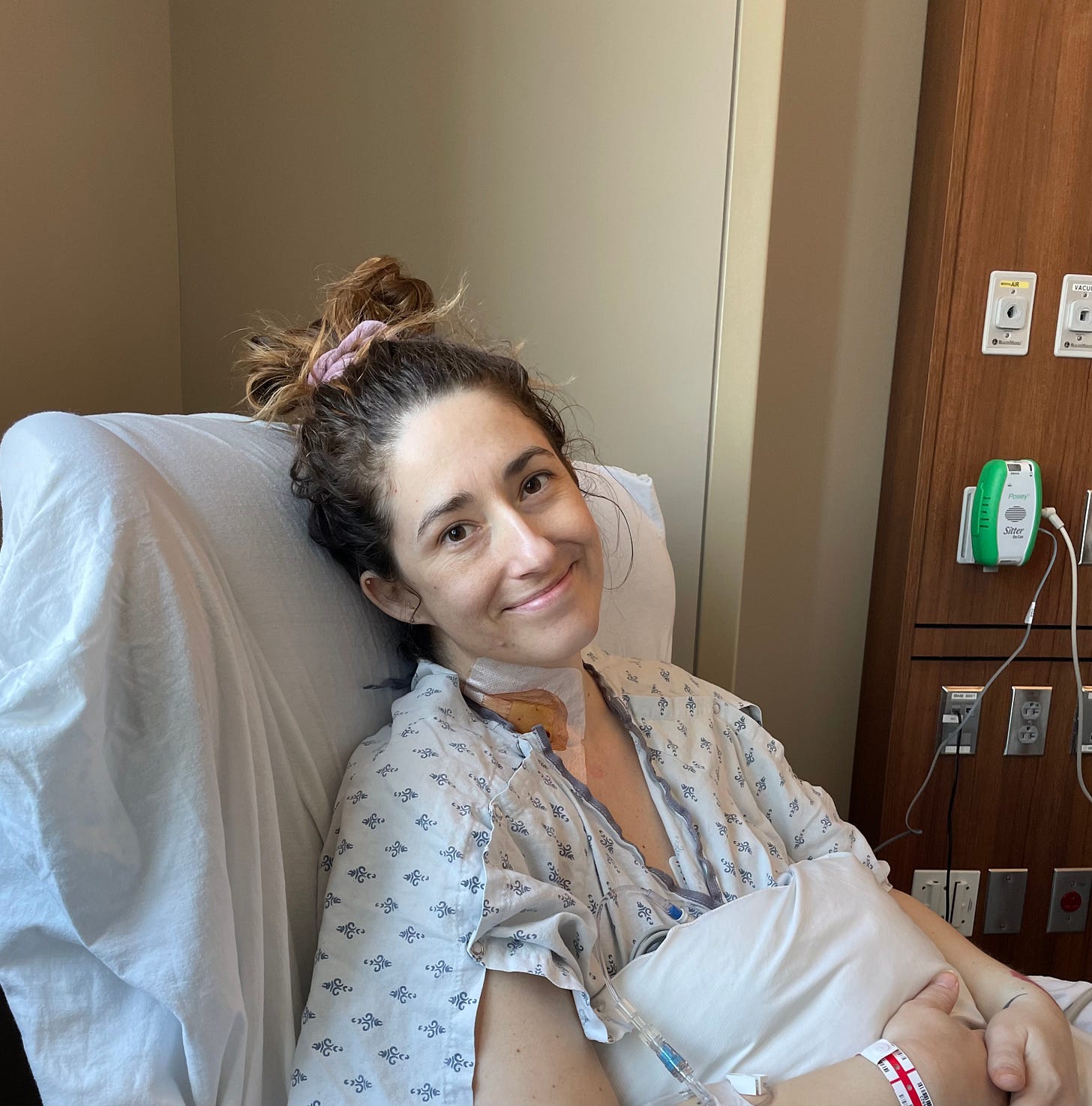How do you begin to write about the time you almost died? And if it was less than two weeks ago, is it a fool’s errand?
I don’t know. But since childhood writing has been the way I have processed my life — my fears, my hopes, my traumas, my heartbreaks, my longings, my god. I don’t know how to do it much differently, even at nearly 40. So I’m going to try this, knowing it will be insufficient, knowing it will be incomplete, knowing that some things are not for public consumption, but forming an alphabet around trauma in the best way I can because language is the only therapy I know.
On the night of February 20 I woke up a few hours after falling asleep with debilitating stomach pain. Immediately, I recognized it as the same pain that had visited almost exactly a month before and lasted for three days. The first time, I had also had strep throat and was home alone with three kids for the weekend in heavy snow, just trying to make it through. I never sought help. This time, I promised myself I would get medical attention.
When I threw up a few hours later, I assumed I had caught the stomach bug that my first grader had the day before; assumed these were two different ailments; never assumed my body was attacking itself in a futile attempt to protect me. Never assumed that my life was in danger.
The next morning I called my primary doctor, whom the receptionist said wouldn’t be able to see me for two days. I called my midwife’s office, which has been the backbone of my medical care for the past seven years. My favorite midwife was not in that day so I demured and said I would wait. They gave me a high dosage of over the counter meds to take with a stern warning to get to the ER if the pain didn’t subside.
By the end of the day, the pain had not subsided. But going to the ER was an investment of hours and money that I didn’t want to make, so I decided I would wait until the morning. When I called the doctor on February 22nd there was an opening available. It was snowing hard, schools closed just hours after opening, and I toyed with the idea of staying in my warm bed and just riding it out. Instead, Eric and two of our kids hauled me to the doctor, who took one look at me, ordered labs, and within minutes had me in the ER because she didn’t want to wait for insurance permission to run a CT scan.
I hadn’t realized how sick I was until I got out of bed and left the house. In the ER, the CT scan showed appendicitis and a probable autoimmune disease. I was desperate for them to whisk me off to surgery to make the pain stop, but as I shivered under piles of blankets they informed us that my condition was too critical to do that. My blood pressure was plummeting and my red blood cells were barely hanging on. I needed blood pressure medication and a blood transfusion before they could operate.
They took me to the ICU, where nurses looked at me like they were seeing a ghost and everyone seemed to be commenting on the color of my lips. Someone explained to us the word sepsis but I was just begging for water, which I couldn’t have. What did I care about sepsis? It seemed to just mean super sick and, yeah, I had picked up on that. Only later would I learn that the mortality rate for sepetic shock is close to 50%. I remember telling Eric that I just needed them to put me in surgery. Everything would be OK once they did surgery. What was taking so long? I could feel my physicality shrinking every moment; knew without saying it that this is what it felt like when you start to go.
Two units of blood into my veins later, I got my wish. They put a central line in my neck, with a tube that I would later learn reached almost to my heart. I went under anesthesia — sweet relief — then they removed my appendix and took a look around my guts. I spent the next two days in the ICU continuing to receive blood pressure meds through an IV to get me stable enough to move to the main floor.
Those two days were a blur. The pain was intense but the narcotics were strong and helped me sleep. Family came. A close friend who is a doctor joined my care team. Eric slept on the cot beside my bed, asking everyone who entered the room if I could have cancer. He was more terrified than I was, because he had the cognitive faculties to be. We fixated on the quest for a diagnosis because at least it was concrete.
We weren’t the only ones looking for a diagnosis. My appendix alone wasn’t bad enough to merit a septic shock response, and definite signs of an autoimmune disease, likely Crohn’s, were present in my CT scan — but less so when they actually cut me open. My medical team was incredible, leaving no stone unturned and sometimes disagreeing between themselves. I had a pelvic ultrasound that showed nothing and an MRI that aligned with a possible Crohn’s diagnosis. A colonoscopy would be the only way to know for sure, but my body was too weak for that. It would need weeks to regain the strength necessary for that test.
Meanwhile, my unconscious was scrambling to translate the trauma. Every time I closed my eyes I was met with an onslaught of images, both pictures and short clips, more rapid fire than I can explain. Like someone shuffling cards containing everything in my brain — over and over and over again. It was sometimes beautiful, sometimes interesting, sometimes annoying, always exahusting. Two particular instances were deeply profound, but those are still my own secrets to keep for a while more.
On the evening of Feb. 24th I left the ICU and was admitted to the surgical recovery floor, in searing pain moving from the bed to a wheelchair. For the next five days I recovered there with the help of IVs of steroids, antibiotics, iron, potassium, and a lot of pain meds. Gradually, I was able to stand. I peed without a catheter. I walked on shaky, gumby knees, my whole body swollen with fluids. Gradually, I transitioned off the IV onto oral medication. I began to eat solids again. I moved around the room. My children brought flowers and put a superhero cape on me. I walked the halls. I read books and laughed. I began to heal.
On March 1st a nurse pulled the abdominal drain from my stomach, a foot of tubing worming its way out of my body that still gives me flashbacks of horror. Then a kind man pushed my wheelchair to the curb where Eric had the car waiting. I was ready to be home, and yet I wasn’t. It was terrifying. The hospital volunteer closed the car door behind me and Eric had only driven a few yards before I began sobbing. I am so scared its going to happen again. He stopped the car and put his arms around me. I know. I know. It’s okay.
I knew all the reasons I shouldn’t be worried, but to my body it didn’t matter. My body was — and is — still trying to protect me. It is on high alert. It does not feel safe. It hasn’t forgotten, and it might be a long, long time before it settles down. That’s okay, I remember. My body, she did amazing. She kept me safe. She kept me alive. I owe her endless patience and compassion. I will be gentle. I will be grateful. I will remind her that we are safe now.
When we pulled into the driveway, I’d never seen such a beautiful sight. The children were at their grandparents’ house, and so Eric and I alone walked into our home to take in our resurrected life in silence. I wept quietly through every single room, and what a gift of a partner who can hold space for the vacancy of sound.
Only one room pulled volume from my throat. The dining table was covered with pages of Highlights magazines left mid-word search, a few wayward pens, a little bowl of abandoned Cheerios and a milky spoon. Sunlight poured in from the window; a vision, a revelation.
A resurrection.






Thank God you came through this scary health crisis, beautiful Shannon! And thank you for sharing it with your readers. You are a brave/authentic/amazing woman! I will pray for your recovery of good health, strength, and vigor.
❤️🙏
Carol Wheelet
Excellent story. I'm elated to see you're on the road to full recovery.